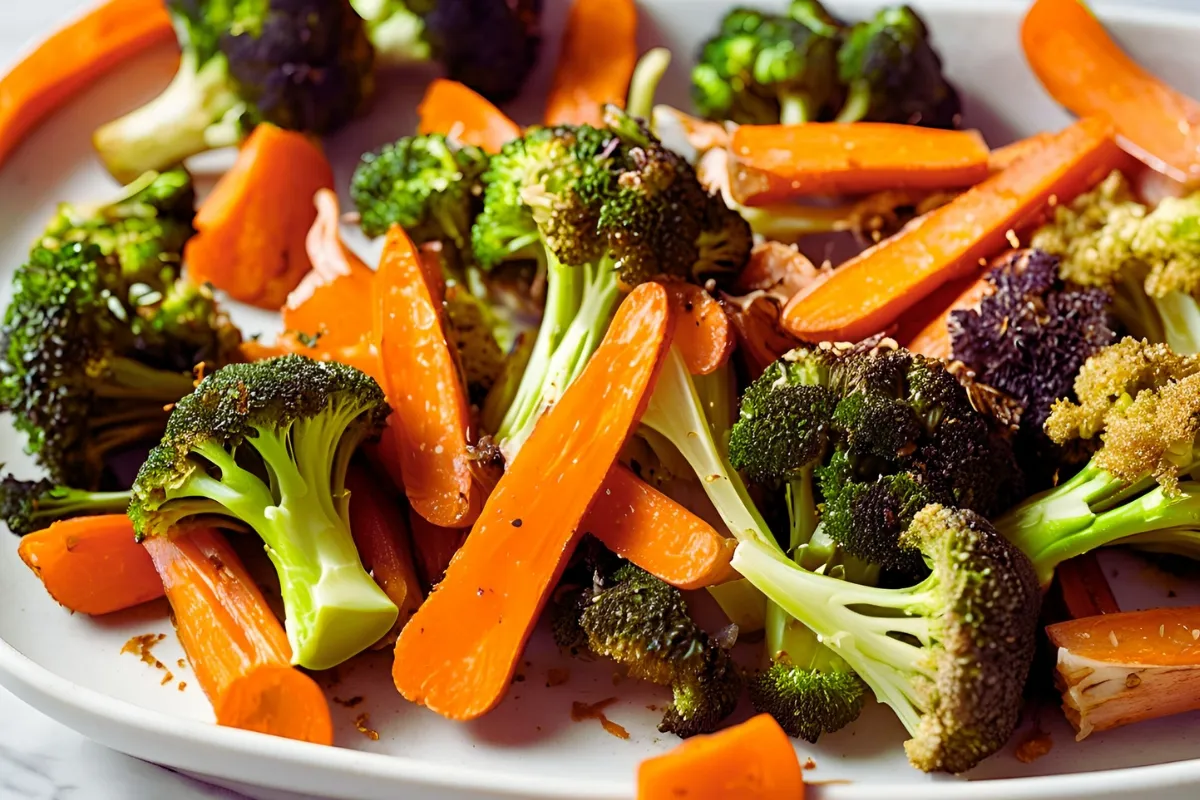When it comes to whipping up a side dish that’s both mouthwateringly tasty and healthy, roasted broccoli and carrots might just be the MVPs of your dinner table. They’re easy to make, require minimal prep, and are a hit with both kids and adults alike. But why stop at just “good enough”? Understanding the art and science behind roasting can turn these everyday veggies into a flavor-packed superstar side dish. For more tips on roasting vegetables, check out this article from Healthline. Let’s dive in!
Why Roasting Enhances the Flavor of Vegetables
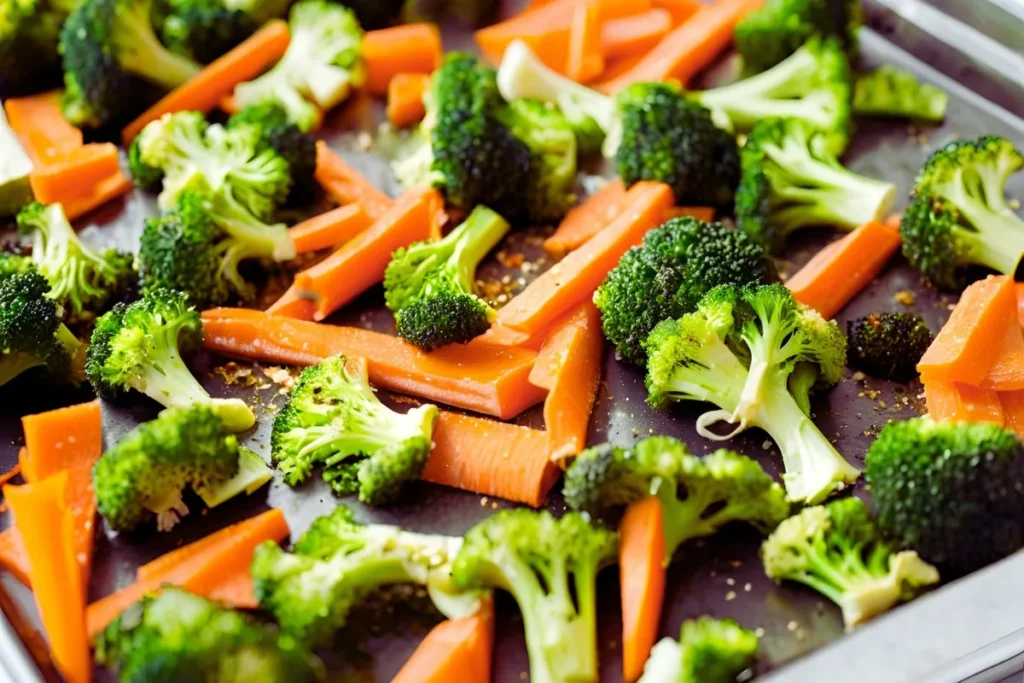
There’s something almost magical about roasting vegetables. Toss them in some olive oil, sprinkle on your favorite spices, crank up the heat, and suddenly, they transform into golden, crispy, and slightly caramelized bites of perfection. But why does this happen?
The Science of Roasting Vegetables
Roasting vegetables works wonders because of the Maillard reaction. Sounds fancy, right? Essentially, it’s the process where high heat triggers the sugars and proteins in food to break down and recombine into flavorful compounds. This is why roasted broccoli gets those irresistible crispy edges and carrots develop a deep, natural sweetness.
How High Heat Brings Out Natural Sweetness
When vegetables like broccoli and carrots are exposed to high temperatures (think 400°F), their natural sugars start to caramelize. This is why carrots taste sweeter after roasting and why broccoli’s edges develop a delightful crunch. Plus, the high heat reduces water content, concentrating the flavors even more.
Who Can Benefit from Learning to Roast Broccoli and Carrots?
If you’ve ever found yourself stuck in a veggie rut—steaming the same greens or serving boring salads on repeat—learning to roast is about to change your game.
Home Cooks Looking for Easy Recipes
Whether you’re a seasoned cook or just starting out, roasted broccoli and carrots are foolproof. With only a few ingredients and no complicated techniques, this dish is as easy as it gets. Perfect for weeknight dinners or last-minute sides!
Health-Conscious Individuals Seeking Nutritious Options
For those watching their waistline or just aiming to eat cleaner, roasted veggies are a dream come true. Low in calories, high in fiber, and loaded with essential vitamins like A, C, and K, this dish offers all the health benefits without skimping on flavor.
Common Misconceptions About Roasting Vegetables
Despite how simple it is, some myths about roasting vegetables might keep you from giving it a try. Let’s clear up a couple of the big ones.
Do Roasted Vegetables Lose Nutritional Value?
Some people worry that high heat destroys nutrients in vegetables, but the truth is, roasting actually helps retain most of the good stuff—especially compared to boiling. Plus, the nutrients that do degrade, like vitamin C, are minimal and balanced out by the fantastic flavor roasting adds.
Is Roasting Time-Consuming?
Not at all! Sure, you’ll need about 20-25 minutes in the oven, but the prep time is super short—just wash, chop, and toss with oil and seasoning. While the veggies roast, you can focus on the rest of your meal (or sneak in a quick break!).
Understanding the Basics of Roasting Broccoli and Carrots
If you’ve ever wondered why some roasted vegetables turn out perfectly caramelized while others end up limp or unevenly cooked, it all comes down to technique. Mastering the basics of roasting broccoli and carrots can make a world of difference, and trust me, it’s easier than you think.
Ideal Roasting Temperatures for Vegetables
Temperature is everything when it comes to roasting vegetables. For broccoli and carrots, the sweet spot is typically 400°F. At this temperature, the veggies roast evenly, getting crispy on the outside while remaining tender on the inside.
That said, not all ovens are created equal. Some ovens may run a little hot or cold, so keeping an eye on your veggies the first time you roast them is a good idea. Using a thermometer to check your oven’s accuracy can save you from over- or under-roasting your veggies.
Essential Ingredients Needed for Roasting
The beauty of roasting is that you don’t need a laundry list of ingredients. Here’s what you’ll want to gather:
Olive Oil, Spices, and Optional Add-Ins
- Olive oil: This is your roasting MVP. It helps the vegetables crisp up and adds a subtle richness. Avocado oil works well too if you’re looking for a neutral alternative.
- Salt and pepper: Keep it classic with these staples, or use garlic powder, paprika, or chili flakes for an extra kick.
- Optional add-ins: Want to take your veggies to the next level? Add minced garlic, a squeeze of lemon juice, or a sprinkle of Parmesan cheese right before serving.
Step-by-Step Guide on How to Roast Broccoli and Carrots
Perfectly roasted veggies aren’t rocket science, but there are a few key steps to follow to guarantee success.
How to Prep Broccoli and Carrots for Roasting
- Washing and cutting techniques: Start by giving your vegetables a good rinse under cold water. For broccoli, cut the florets into evenly sized pieces, and don’t toss the stems—they roast beautifully when sliced thin. For carrots, peel and slice them into sticks or coins, aiming for uniform sizes so everything cooks evenly.
How to Season Vegetables for Optimal Flavor
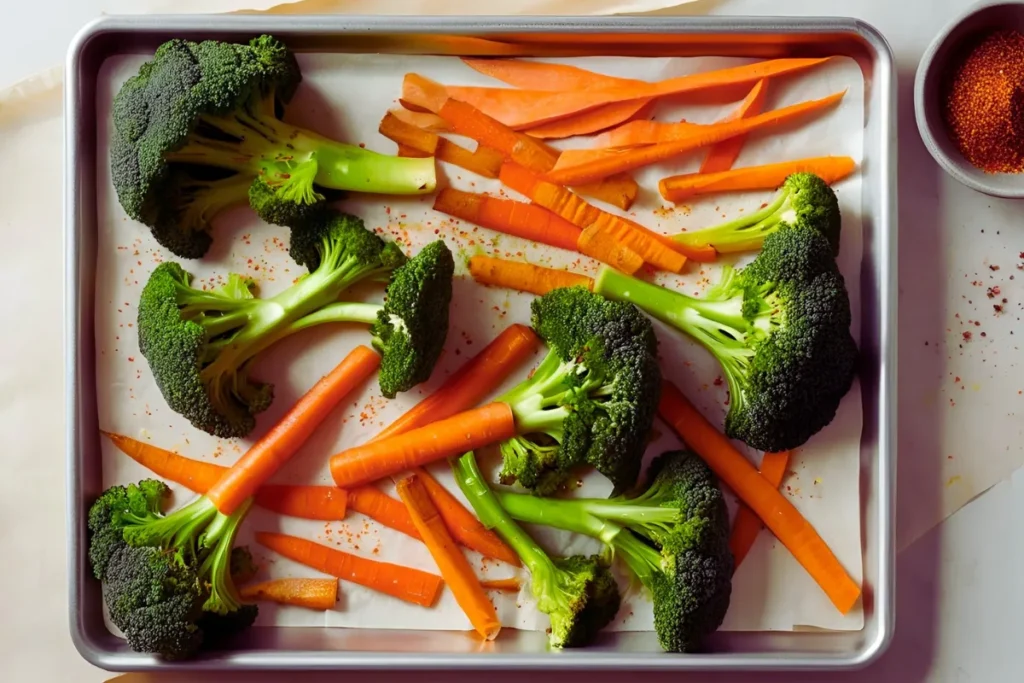
The secret to flavorful roasted veggies lies in the seasoning. After cutting your broccoli and carrots, toss them in olive oil until they’re lightly coated (but not drenched). Then, sprinkle with salt, pepper, and any additional spices you love. Massage the seasoning onto the veggies to ensure even coverage.
Tips for Arranging Vegetables on the Baking Sheet
Here’s a biggie: don’t overcrowd your pan! Spread the veggies out in a single layer with a little space between each piece. If they’re crammed together, they’ll steam instead of roast—bye-bye crispy edges! For best results, use a large baking sheet or divide the veggies between two pans.
How Long to Roast Broccoli and Carrots at 400°F
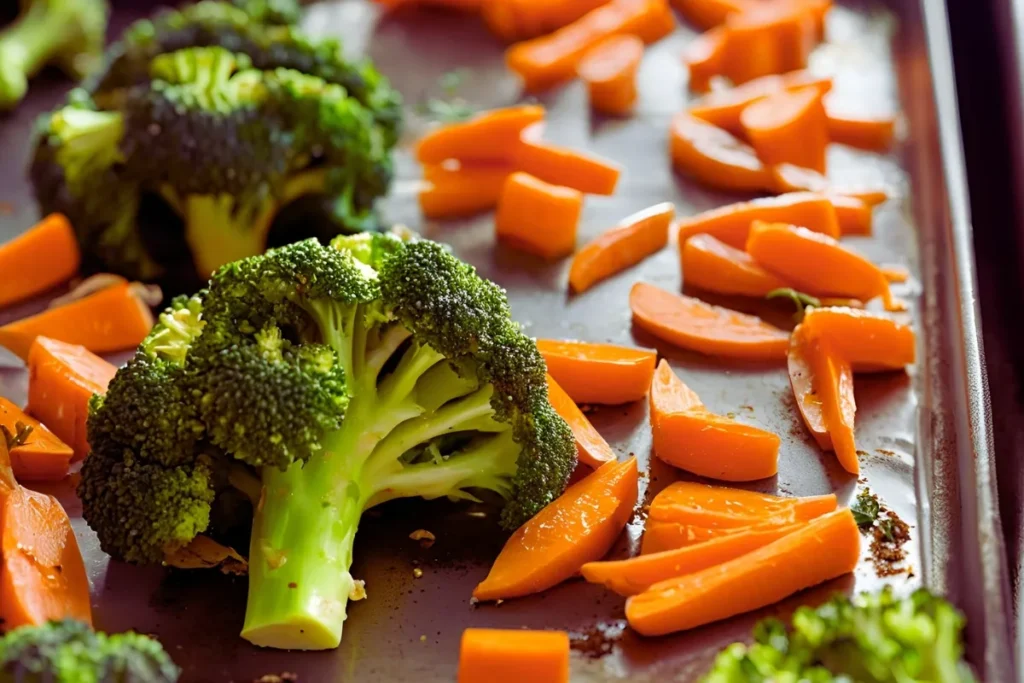
Cooking times can vary depending on your preferences, but here’s a good starting point:
- Broccoli: 20–25 minutes
- Carrots: 25–30 minutes
For even cooking, toss the vegetables halfway through the roasting time.
Adjusting Cooking Times Based on Desired Crispness
If you like your veggies a little softer, shave 2-3 minutes off the cook time. Prefer extra crispy edges? Leave them in for a few minutes longer, but keep an eye on them to avoid burning.
Factors That Impact Roasting Times (Oven Type, Veggie Size)
- Oven type: Conventional ovens might take longer, while convection ovens with a fan can speed things up.
- Veggie size: Larger pieces of broccoli or thick carrot slices will take longer to cook than smaller, more uniform cuts.
Signs Your Vegetables Are Perfectly Roasted
Look for these visual cues:
- Broccoli: Crisp, slightly charred edges and tender stems.
- Carrots: A golden-brown surface and a soft interior when pierced with a fork.
Health Benefits of Roasted Broccoli and Carrots
Roasted broccoli and carrots aren’t just tasty—they’re incredibly good for you too!
Rich in Vitamins and Antioxidants
Broccoli is packed with vitamin C, vitamin K, and antioxidants that can boost your immune system and support bone health. Carrots, on the other hand, are rich in beta-carotene, which converts to vitamin A and promotes good vision and skin health.
Low-Calorie, High-Fiber Side Dish Option
At under 150 calories per serving (depending on the oil and seasoning used), this dish is a guilt-free addition to any meal. Plus, the fiber content in both veggies helps with digestion and keeps you feeling fuller for longer.
Creative Ways to Serve Roasted Broccoli and Carrots
Once you’ve mastered the art of roasting broccoli and carrots, the fun really begins. These versatile veggies can be dressed up or kept simple, making them a perfect match for nearly any main dish. Whether you’re preparing a weeknight dinner or entertaining guests, roasted vegetables can steal the show with a few creative twists.
For an added twist, try serving your roasted veggies with Asian Chicken Cranberry Salad—the fresh, tangy flavors elevate the dish!
Pairing Roasted Vegetables with Main Dishes
Roasted broccoli and carrots are like the little black dress of side dishes—they go with just about anything.
Perfect Complements to Chicken, Fish, or Tofu
- Chicken: Pair roasted veggies with baked chicken thighs or a lemon herb roasted chicken. The flavors work together beautifully, and the vibrant veggies add a pop of color to your plate.
- Fish: A flaky salmon filet or pan-seared cod is elevated when served alongside crispy roasted broccoli and carrots. Add a wedge of lemon for a fresh, zesty touch.
- Tofu: For plant-based eaters, roasted broccoli and carrots are the ideal companion to marinated and baked tofu. A sprinkle of sesame seeds or a drizzle of soy sauce ties it all together.
Customizing Your Roasted Broccoli and Carrots
The beauty of roasted veggies lies in their adaptability. You can keep it classic or get adventurous with bold flavors and unexpected additions.
Adding Garlic, Lemon, or Parmesan for Extra Flavor
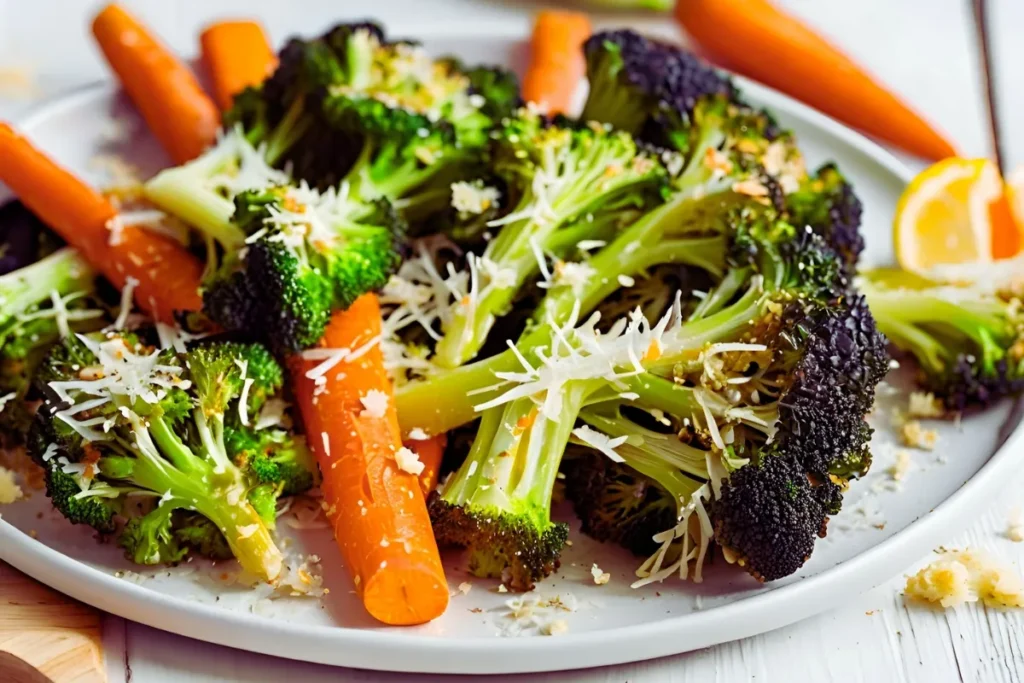
- Garlic: Toss minced garlic with the broccoli and carrots before roasting, or roast whole garlic cloves alongside them for a mellow, sweet flavor.
- Lemon: Add a squeeze of fresh lemon juice and a sprinkle of zest after roasting for a bright, tangy kick.
- Parmesan: Sprinkle grated Parmesan cheese over the veggies during the last 5 minutes of roasting for a rich, nutty flavor.
Making Spicy or Sweet Variations
- Spicy: Love a little heat? Add a dash of cayenne pepper, chili flakes, or smoked paprika to your seasoning mix.
- Sweet: For a sweeter twist, toss the carrots in a drizzle of honey or maple syrup before roasting. This caramelizes in the oven, creating a delectable glaze.
Common Challenges and How to Solve Them
Even the best cooks run into hiccups now and then. Here’s how to tackle some common issues when roasting broccoli and carrots.
Vegetables Turn Out Soggy Instead of Crispy
- Problem: Overcrowding the pan or using too much oil can cause your veggies to steam instead of roast.
- Solution: Spread the vegetables out in a single layer with space between each piece, and use just enough oil to lightly coat them.
Uneven Cooking: Avoiding Burnt or Undercooked Pieces
- Problem: Large or unevenly cut pieces can cook at different rates, leaving some veggies overdone while others remain undercooked.
- Solution: Cut broccoli florets and carrot slices into uniform sizes, and toss halfway through roasting to ensure even cooking.
Summary of Key Points
Roasting broccoli and carrots is simple, but a few tips and tricks can take your veggies from “meh” to memorable.
Quick Checklist for Perfect Roasted Vegetables
- Preheat your oven to 400°F.
- Cut vegetables into even-sized pieces.
- Toss with olive oil, salt, and spices of your choice.
- Arrange in a single layer on a baking sheet.
- Roast until golden brown, tossing halfway through.
Encouragement to Experiment with Flavors and Techniques
Don’t be afraid to get creative! Whether you’re adding Parmesan, trying a spicy rub, or tossing in fresh herbs, there’s no wrong way to roast vegetables. Experimentation is part of the fun, so mix it up and find your favorite combinations.
Tools and Resources for Roasting Vegetables
While you don’t need any fancy gadgets, having the right tools can make roasting even easier and more enjoyable.
Best Baking Sheets and Utensils for Roasting
- Baking sheet: A sturdy, rimmed baking sheet ensures your veggies don’t slide off during roasting. Opt for one with a nonstick surface or use parchment paper for easy cleanup.
- Utensils: A silicone spatula or tongs are perfect for tossing and flipping veggies midway through roasting.
Links to Other Simple Vegetable Recipes
If you’re loving roasted broccoli and carrots, why not try your hand at other roasted veggie recipes? Here are a few ideas to spark your inspiration:
- Roasted sweet potatoes with cinnamon and nutmeg.
- Crispy Brussels sprouts with balsamic glaze.
- Herb-roasted zucchini and squash.
FAQs About Roasted Broccoli and Carrots
Here are some common questions people have about roasting broccoli and carrots. Whether you’re a beginner or a seasoned home cook, these answers will help you roast like a pro!
How Do You Roast Carrots and Broccoli?
Roasting carrots and broccoli is simple! Start by preheating your oven to 400°F. Wash and cut the vegetables into evenly sized pieces, then toss them with olive oil, salt, and your preferred seasonings. Arrange them in a single layer on a baking sheet and roast for 20–30 minutes, tossing halfway through. The high heat ensures crispy edges and tender insides, making this an effortless side dish for any meal.
What Is the Best Temperature for Roasting These Vegetables?
The ideal temperature for roasting broccoli and carrots is 400°F. This allows the vegetables to cook evenly while developing that golden-brown caramelization we all love. However, you can adjust slightly if needed—for example, 375°F for a slower roast or 425°F for crispier results. Just be sure to check on them as they cook to avoid burning.
How Long Should I Roast Broccoli and Carrots at 400°F?
At 400°F, broccoli typically takes 20–25 minutes, while carrots may need 25–30 minutes due to their density. To ensure even cooking, cut the veggies into uniform pieces and toss them halfway through the roasting time. If you’re unsure, look for browned edges and a fork-tender texture as signs that your veggies are ready.
What Seasonings Work Best for Roasted Broccoli and Carrots?
The options are endless when it comes to seasoning! A simple mix of salt, pepper, and olive oil works beautifully, but you can also experiment with garlic powder, smoked paprika, or Italian herbs. For added flair, try finishing with fresh lemon juice, Parmesan cheese, or a drizzle of balsamic glaze. Sweet options like honey or maple syrup also pair wonderfully with carrots.
Do I Need to Preheat the Oven Before Roasting?
Yes, always preheat your oven before roasting vegetables. Starting with a hot oven helps the broccoli and carrots cook evenly and develop those crispy edges. If you skip preheating, the veggies might cook unevenly, resulting in soggy or underwhelming textures.
How Do I Keep Roasted Vegetables from Sticking to the Pan?
To prevent sticking, lightly coat your baking sheet with nonstick spray or line it with parchment paper. Additionally, ensure the vegetables are evenly coated with oil before roasting, as this creates a natural barrier between the veggies and the pan. If you’re still having trouble, try investing in a nonstick or silicone baking mat.
Can I Make Roasted Broccoli and Carrots Ahead of Time?
Absolutely! You can roast broccoli and carrots ahead of time and store them in an airtight container in the fridge for up to 3–4 days. To reheat, spread the veggies on a baking sheet and warm them in a 375°F oven for 5–10 minutes. This method preserves their texture better than microwaving, which can make them soggy.
Part 4 is complete. Would you like me to proceed to SEO Metadata?

